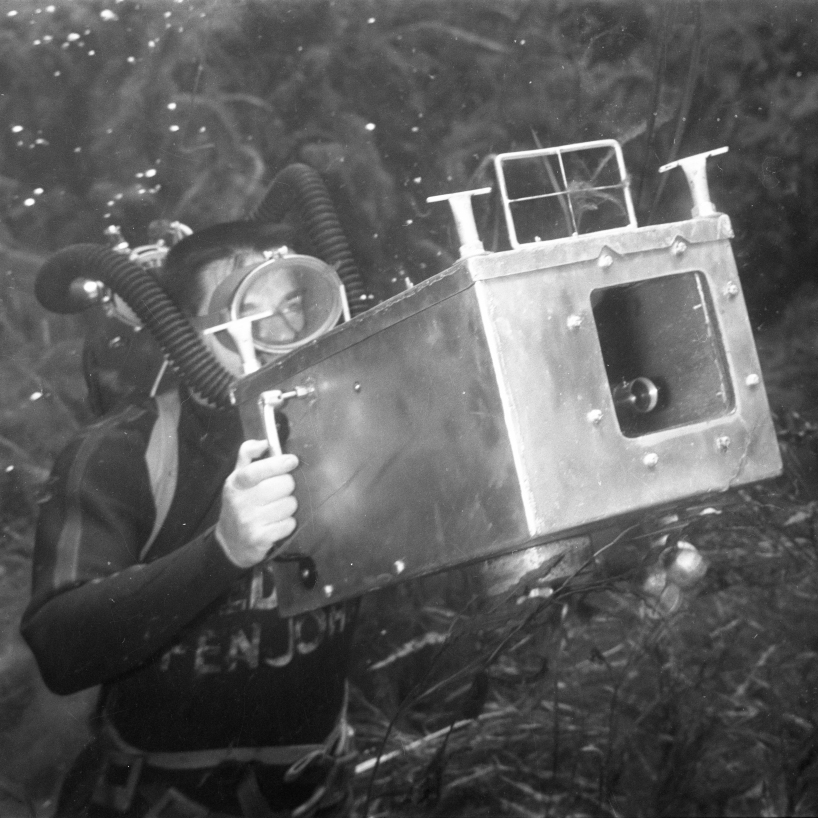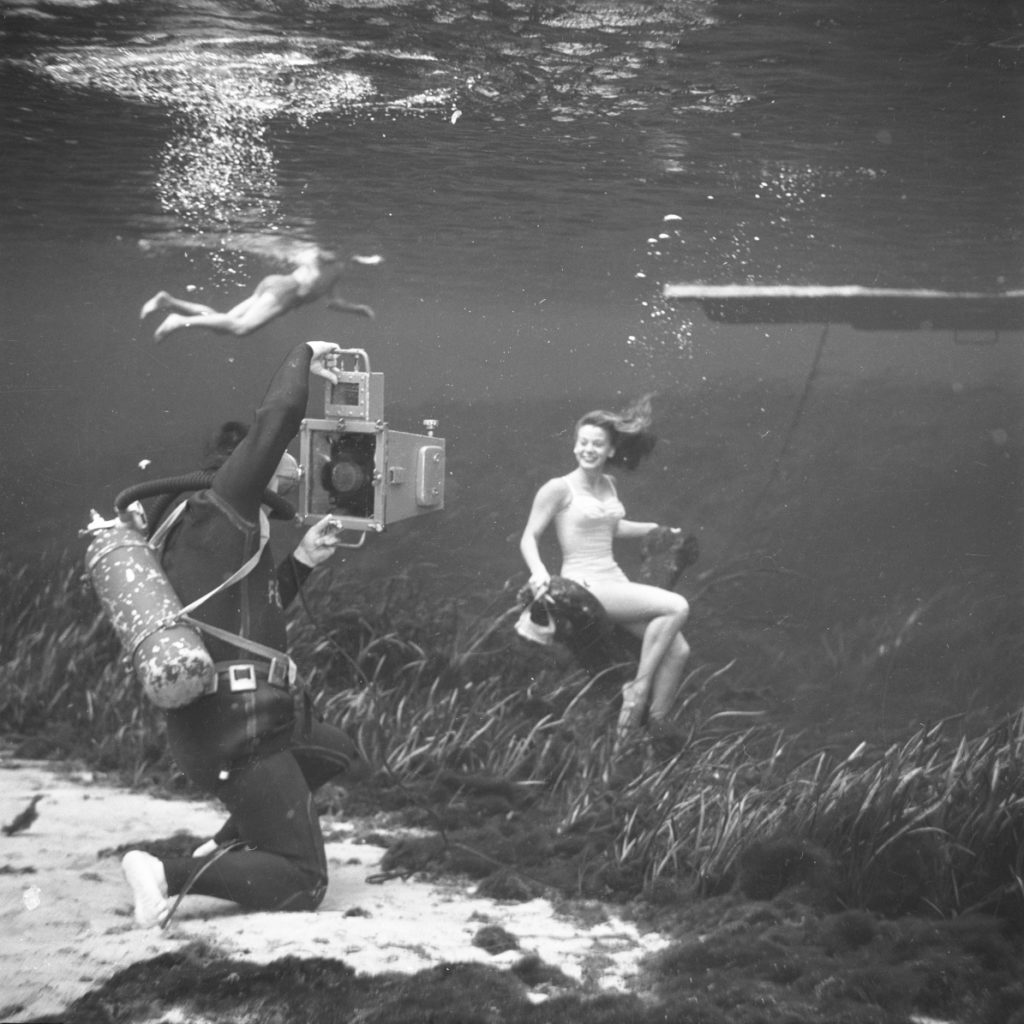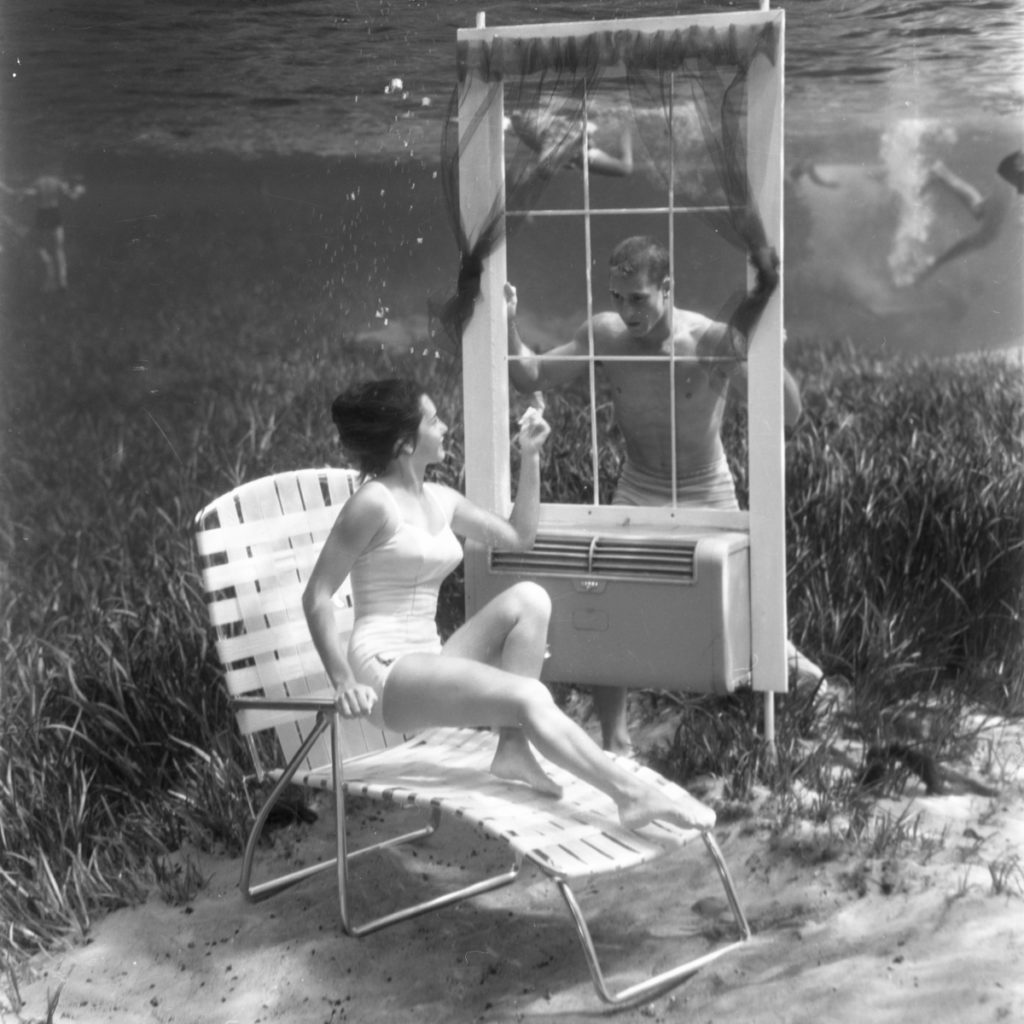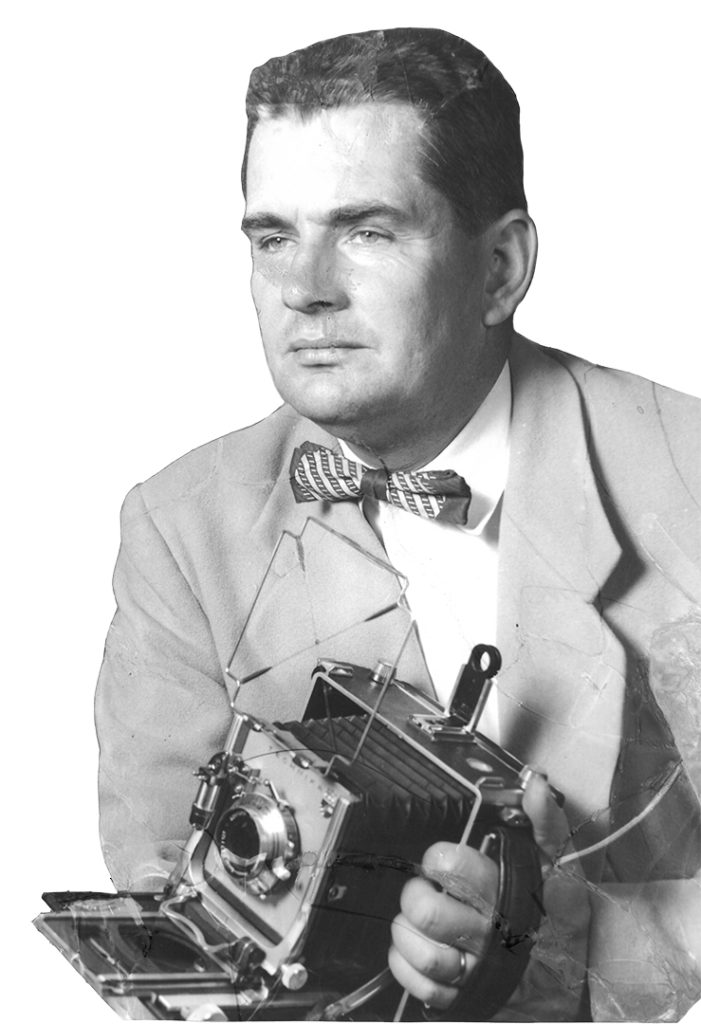A true pioneer of underwater photography, Bruce Mozert’s iconic images drew tourists to Silver Springs for decades and serve as an enduring legacy to one man’s labor of love.

Anybody who ever stepped inside Bruce Mozert’s tiny studio in Silver Springs would have collided with hundreds of photos strewn across two desks and plastered on all four walls. Visitors walked among piles of crudely built waterproof camera housings, assorted pieces of inventions he hadn’t yet figured out, and a filing cabinet crammed with negatives from his 30-year career as Silver Springs’ official photographer.
Even in his mid-90s, Mozert perked up at the sight of a visitor coming through his door. The white-haired champion of underwater photography instantly morphed into a younger version of himself as he reminisced over the high points of his career. His eyes sparkling, he’d sit on a rolling chair and pass from one artifact to another, showing off the numerous contraptions that made him an icon of his time.
Mozert died on October 14th, 2015, just a few weeks before his 99th birthday, leaving behind a legacy of photos, negatives and inventions. A couple of years later, the long process of sorting through Mozert’s treasure trove began, with several people—who found themselves amazed by the scene—showing up to help.
Among them, Alan Youngblood, an accomplished underwater photographer in his own right, was astounded by what he uncovered. Some of Mozert’s early inventions had crude beginnings, fashioned from scrap metal, Plexiglas, soldering wire and rubber inner tubes, but they worked. Back in Mozert’s day, photographers didn’t have the high-tech equipment that’s available today.
“When they got into the business, they had to make everything,” Youngblood notes. “Today, when I’m photographing underwater, I’m literally standing on the shoulders of giants and Bruce Mozert is one of them. I get to dive with state-of-the-art modern equipment. He didn’t have any of that and he made beautiful pictures. He had the right attitude for anyone in the business. If someone asked him to do something, he said, ‘Sure,’ and he’d figure it out later. He pioneered underwater photography.”
As a photojournalist, Youngblood photographed Mozert a number of times.
 “There was always plenty of chitchat,” Youngblood recalls. “He would answer whatever you asked him. He talked to me a little bit about filtering, and he pointed out the value in thinking through a problem and developing whatever you needed to do to accomplish it. That skill has served me not only in photography, but in anything that I do.”
“There was always plenty of chitchat,” Youngblood recalls. “He would answer whatever you asked him. He talked to me a little bit about filtering, and he pointed out the value in thinking through a problem and developing whatever you needed to do to accomplish it. That skill has served me not only in photography, but in anything that I do.”
Esteemed local natural history photographer Mark Emery also holds Mozert in high regard.
“He absolutely solved a problem nobody else could solve,” Emery remarks. “He found a way to do it. He was involved in making a photo boat with a glass bottom and 6-foot glass case all around. You could walk down steps and now you were six feet below the water. It was an amazing way to see the Silver River, like a diver would see it, at least the first couple layers.”
Often surrounded by beautiful young women, Mozert considered them pleasant-looking props, no different from photographing a two-by-four piece of wood or a dilapidated stove he’d somehow managed to sink to the bottom of the main spring.
He directed his bathing beauties in a variety of poses—standing on tiptoe to emphasize the sleek lines of their legs, shooting up at them to make the shorter ones appear taller, and placing them underwater, cooking on a grill, lounging in a lawn chair, playing golf and being hauled off by a sea monster.
Such was the fate of Ginger Stanley (now Hallowell), who was the stunt swimmer in Creature from the Black Lagoon and its sequel, Revenge of the Creature. She also posed for many of Mozert’s advertisement photos that promoted the films and Silver Springs as a tourist attraction.
Now 88 years old and living in Orlando, Hallowell recalls that Mozert showed total respect for all of his models.
“He appreciated the fact that we looked good and that he could photograph us, but at the same time it was almost like we were inanimate objects, like a doll that he could pose. He was a total gentleman.”
All the while, Mozert’s mind was on the next project.
“You could always see the wheels turning.” Hallowell laughs. “Many times, he’d get ahead of himself. He would say, ‘Hey, I think we can do an underwater circus and we can get NBC here and I can make all the props. We can have a snack stand with a canopy over it and we can get one of Ross Allen’s snakes and you can be a snake charmer.’ There was always a twinkle in his eyes, because he always had a thought. His expression would change, and, in his mind, he would go through the whole little short subject [film] that he was going to put you in. He had already seen the end, and the end was always a comedy or a surprise.
“One time, we took an old jalopy down in the water, along with a picnic basket and a tablecloth, and we spread out an underwater picnic,” Hallowell recalls with a giggle. “We actually got in the car as it rolled down the bank and into the water. It was very unusual and kind of fun.”
One of Hallowell’s scenes in Creature from the Black Lagoon involved an unplanned swimming “dance” she did with underwater Creature double Ricou Browning.
Now 90, Browning, of Fort Lauderdale, has fond memories of working at Silver Springs, like the time he and Mozert set up an underwater radio station that really worked.

“One time, Ginger swam the whole length of the Silver River underwater,” Browning remembers. “Bruce filmed it and I was there just giving her air. She stayed underwater several miles, all the way to the end.”
Mozert didn’t start out with a camera in his hand. Born on November 24th, 1916, in Newark, New Jersey, he moved with his family to a chicken farm in Scranton, Pennsylvania. After graduating from high school, he took a job driving a coal truck. Not one to sit still for very long, he followed his sister Zoe, a professional model, to New York City where he began working as a film developer for LIFE Magazine, earning $3 a week.
In 1938, while in Miami on an advertising shoot, Mozert heard a movie studio was about to shoot a series of Tarzan movies at Silver Springs. He dropped what he was doing and came to Ocala. Media personality Buddy Martin was just 3 when he met Mozert.
“My dad, Wilton Martin, was the first public relations director at Silver Springs,” notes Martin. “He actually brought Bruce to Ocala. I remember Bruce coming to our house and setting up his darkroom in our bathroom. I remember going in the bathroom and seeing strips of film hanging on our shower curtain. My dad was the one who pushed Bruce to invent the underwater camera.”
During his career as Silver Springs’ official photographer, Mozert rubbed elbows with numerous stars who came to town with Hollywood filmmakers. His collection of photos includes shots of Gregory Peck, Lloyd Bridges, Esther Williams and a host of others. Mozert’s work appeared on the covers of major magazines, and his movie shorts were shown in news clips that played before feature films at movie houses across the nation. One of them, a Thanksgiving dinner with a real turkey eaten underwater, made it to the big screen every November for a few years.
But, Mozert’s life wasn’t all work and no play. Ryan Mozert, who lives in Gainesville, says whenever he spent time with his grandfather they got away from the studio and did other things, like fishing trips to Cedar Key with Ryan’s brother Clint, and their dad, Scott Mozert.
“I worked with Bruce all the way up to two weeks before his death,” reminisces Ryan. “We went to the lake, setting up a satellite, picking up branches, painting. He taught me how to fix jet skis and outboard motors. He was great, very loving and had a good business sense about him. He was a Christian. He belonged to the Lions Club and used to fix bicycles and give them to homeless people.”
 As for Mozert’s collection, after his death it fell into the hands of Evelyn Yorlano, his “girl Friday” for 38 years.
As for Mozert’s collection, after his death it fell into the hands of Evelyn Yorlano, his “girl Friday” for 38 years.
“He never threw anything away,” Yorlano sighs. “His mind was always going 100 miles an hour, thinking how he would make something or fix something.”
As executor of Mozert’s estate, Yorlano kept the office open until his estate was settled and the collection ready for another home. In desperation, she enlisted the help of local journalist and photographer Dave Schlenker.
Schlenker had a professional and a personal relationship with the man he describes as “an icon of photography.”
“When I was in photo school, I needed a large format camera,” Schlenker recalls. “I didn’t have access to one, so I called Bruce up to find out where I could get one. He said, ‘Meet me at my studio.’ He had a large format camera there. He said, ‘Take it for as long as you need it.’ That camera might have photographed Jayne Mansfield and underwater alligators! I got to use it until I finished school.”
Schlenker was not prepared for the “treasures” inside Mozert’s tiny studio.
“The place was like a completely disorganized wonderland,” Schlenker says, chuckling. “He was a bit of a pack rat. We were going through these filing cabinets and finding these iconic images—Jayne Mansfield shoved in there next to a reptile show, aerial photos of Weeki Wachee, Cypress Gardens and Silver Springs, starlet photos in bikinis, Ross Allen—and there’s Bruce’s wife waving and with a suitcase on vacation. I thought, This stuff needs to stay in Marion County.”
He contacted Dr. James Henningsen, president of the College of Central Florida, who arranged a partnership between the college, Marion County and the Florida Division of Cultural Affairs. Together, they bought the collection for $85,000. The majority of artifacts went to the state museum archives in Tallahassee, and a portion remained in Marion County.
“The nice thing about this agreement, it preserved [the collection] for Florida’s history, and made it available to the public,” Henningsen states. “We have a number of originals that were colorized and framed. They’re housed at the Appleton. We would like to display some of those on campus and rotate them.”
Six prints are currently on display in the lobby at the Ocala/Marion County Visitors and Convention Bureau. Jessica Marr, marketing and communications coordinator for tourist development, notes that Mozert has been nominated for admission into the Florida Tourism Hall of Fame. This year’s recipient will be named at the Florida Governor’s Conference on Tourism in September.
Mozert was posthumously named first inductee on Ocala’s Walk of Fame on May 3rd, 2018. Prior to his death, he received a lifetime achievement award at the Silver Springs International Film Festival and also served on a panel with other filmmakers.

“He was such a storyteller,” muses Angie Lewis, a board member for the festival. “I could listen to him for hours. His memory was phenomenal. He would rattle off dates and time periods and stories. It was just mesmerizing.”
Among the other ways Mozert has been memorialized is through the pages of Silver Springs: The Underwater Photography of Bruce Mozert, published in 2008 by Gary Monroe. The hardcover book is filled with the images that put Silver Springs on the map, and helped him earn a place in history. Many of the images show model Betty Frazee Haskins, who worked with Mozert for about three years.
She says that in addition to the underwater images, he also created plenty of daring and creative setups on land.
“We made pictures in different venues, like the limestone pits up in Lowell,” she recalls. “That was a magazine cover. I was sitting on the top of the cliff and Ricou Browning was doing a swan dive off into the water.”
Some of the work was for advertising clients, or for businesses trying out new ideas.
“We did Mercury Motors, all their ads,” Haksins offers. “And people were always testing products at Silver Springs, like Styrofoam, which was beginning to be widely used. They carved a mountain out of Styrofoam and I was on it in something like a red Santa suit and it was floating out in the springs.”
“He always thinking of something kitschy to do and I worked in the PR department for Bill Ray,” she remarks. “Whenever they had something they wanted to do, they called me down and said wear this or wear that. I learned to do things like drinking a Coke underwater, eating a banana. All kind of underwater stuff, but we did a ton of stuff above water too. Sometimes we’d have an animal; an elephant, a snake, a monkey.
She says the publicity pictures went all over the world and the picture of her cooking a steak underwater was on the cover of Smithsonian Magazine. Her photos graced the covers of 21 magazines and she worked on sets for Sea Hunt and a Jerry Lewis movie.
“I was a teenager and pretty game for everything that went on,” she offers. “Bruce was a very interesting man, very creative. He was always saying funny things, but he was dead serious about his work.”
This Fall, the Appleton Museum of Art will host an exhibition of work that showcases both Mozert’s popular underwater advertisements for Silver Springs Tourist Center, as well as historic promotional images for Paradise Park. Both were once operated in Marion County and represent an important part of mid-20th century Florida tourism. For exhibition updates, visit www.appletonmuseum.org






